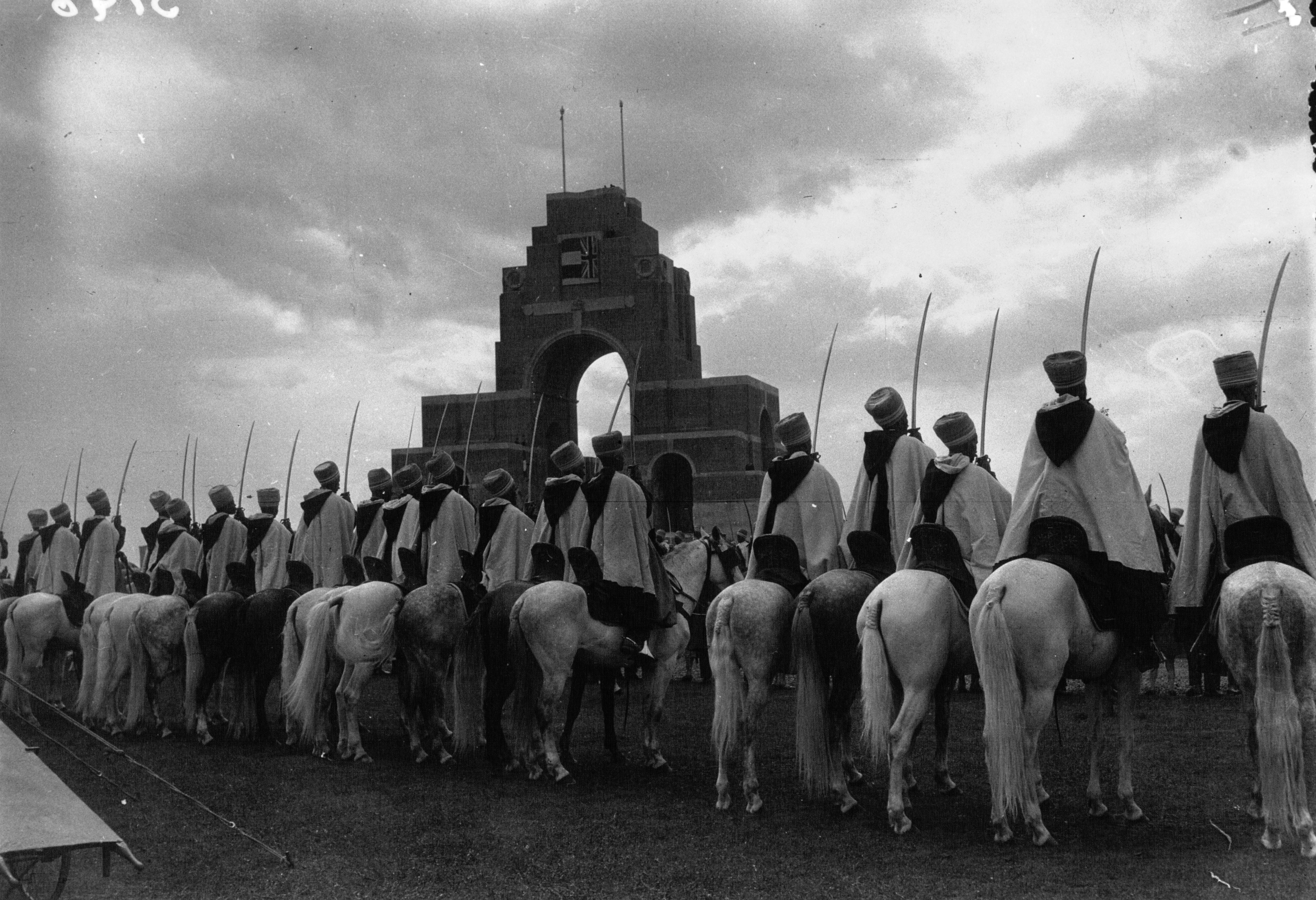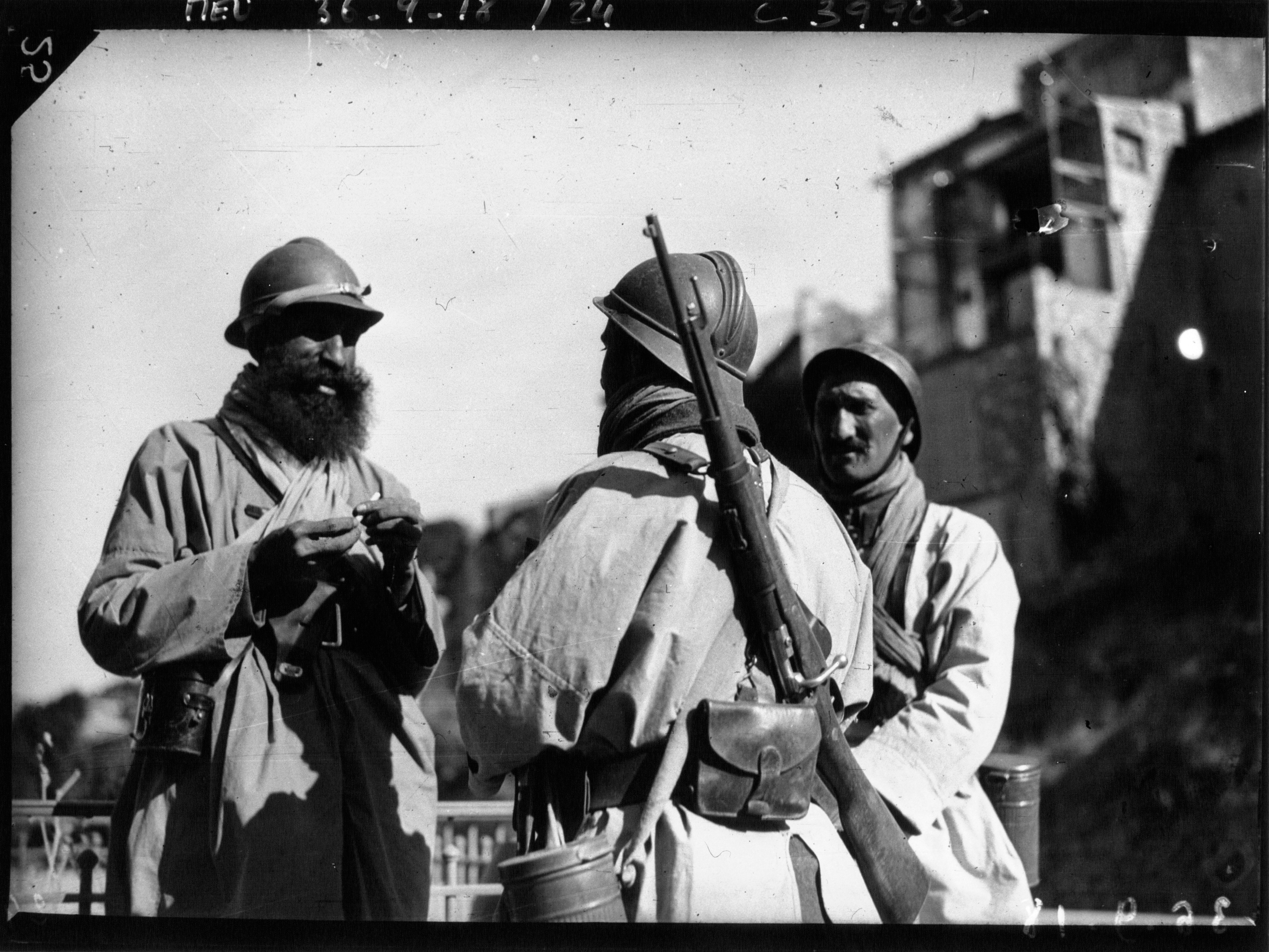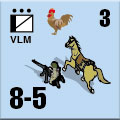Swallows of Death:
Horseshit and Engine Sludge
French Cavalry in 1940
by Mike Bennighof, Ph.D.
April 2023
 Cavalry had played only a minor role on the Western Front during the Great War. Only in the opening and closing weeks of the war did mounted troops fulfill their role; in between, those that saw action did so dismounted and fighting as infantry. Cavalry had played only a minor role on the Western Front during the Great War. Only in the opening and closing weeks of the war did mounted troops fulfill their role; in between, those that saw action did so dismounted and fighting as infantry.
After the war, the French Army re-organized its cavalry into five divisions, each of those with two brigades of horsed cavalry, plus armored cars and bicycle-mounted scouts. In 1932 the cavalry divisions expanded to add a battalion of armored cars and one of mechanized infantry riding unarmored P19 halftracks, plus a company of motorcyclists. The divisions’ performance on maneuvers inspired little confidence, thanks to the differing speeds and logistical requirements of the different unit types. Staff officers derided the cavalry divisions as crottin et cambouis (“horseshit and engine sludge”).
That mixed organization was not unique to the French Army. Most armies formed such “rapid” divisions in the 1930’s, sometimes as an attempt to keep their horsed regiments relevant, and sometimes as a cost-cutting measure to expand their mobile forces with horses rather than expensive new vehicles.
Two of the five French cavalry divisions would be converted as the cavalry branch expansion into mechanized warfare, and become Divisions Légère Mecanique or Mechanized Divisions. The remaining three were mobilized in September 1939 but General Staff studies from earlier that year had already called for re-organization to meet the expected need to screen a German advance through the Ardennes region of eastern Belgium.

The 4th Moroccan Spahis at the inauguration of the Thiepval Memorial, 1932.
The new organization gave the cavalry division one horsed and one mechanized brigade. The horsed cavalry brigade would have two cavalry regiments and a headquarters staff, with a small motorized communications detachment but no further supporting arms. Maurice Gamelin, the chief of the general staff, considered horsed cavalry no longer viable on the modern, mechanized battlefield. It would only be used in heavily wooded or rugged areas, like the Ardennes, and on reconnaissance and security duties. The French Army formed five new cavalry divisions on this model, plus one more in North Africa and an independent horsed cavalry brigade.
Like the Moroccan infantry, two of the five Moroccan regular cavalry regiments, known as Spahis, moved to France between the wars to provide full-strength regular capability that the “active” metropolitan French units could not without an influx of reservists.
The most decorated cavalry regiment in the French Army, the 1st Moroccan Spahis served in Syria. They fought for the Vichy regime against the Allied invasion, and after returning to Morocco, fought the Americans in late 1942. In 1944 they converted into an armored unit, with the Moroccan troopers replaced by white French colonists.
The 2nd Moroccan Spahis fought in the Rif War and against Moroccan rebels through the 1920’s and 1930’s. In 1939 they joined an Algerian regiment to form the 3rd Brigade of Spahis in the Ardennes. There they fought the Germans until late June; the regiment did not re-form until 1947. They fought in Vietnam and served in Germany until their disbandment in 1962.
The 3rd Moroccan Spahis remained in Morocco and later joined the Free French, though by then most personnel were French. They returned to Morocco and were dissolved in 1962.
The 4th Moroccan Spahis, formed in 1927, immediately moved to a garrison at Senlis in France. In 1939 they joined an Algerian regiment to form the 1st Brigade of Spahis. They fought in the Ardennes and afterwards, and in 1943 joined the Free French. They converted to French manpower in 1962 as an armored cavalry unit.
The 5th Moroccan Spahis did not see action in 1940, but joined the Free French and would be the last mounted unit of the French Army to see action on horseback, fighting in the Black Forest in 1945. They were disbanded a year later.

Moroccan Spahis on maneuvers, 1936.
The French Army raised four different types of cavalry regiments in France: hussards, dragons, cuirassiers, and chasseurs. These differed only in the breeds of horses theoretically issued to them. A horsed cavalry regiment, metropolitan or Spahi, had four cavalry squadrons and one heavy weapons squadron. Each squadron had four platoons, each of those with 36 men. A cavalry platoon had two 13-man squads, each with a Model 1929 light machine gun, and a six-man half-squad known as an escouade. A four-man command group rounded out the formation. In action those 36 men became 27, as one man out of four had to be counted off to hold the horses of the other three.
French cavalrymen, both those of metropolitan regiments and Spahis, carried the new MAS36 battle rifle, an unattractive but sturdy bolt-action weapon issued as a stopgap until the new MAS40 semi-automatic version could be made ready for use.
 This made for a completely different organization than an infantry platoon or squad, but gave the cavalry platoon commander needed flexibility to use the escouade to hold all of the platoon’s horses and use his two squads in the usual fashion (with one half, the fusiliers, built around the light machine gun, as a base of fire and the other half, the éclaireuers, as the maneuver element). This made for a completely different organization than an infantry platoon or squad, but gave the cavalry platoon commander needed flexibility to use the escouade to hold all of the platoon’s horses and use his two squads in the usual fashion (with one half, the fusiliers, built around the light machine gun, as a base of fire and the other half, the éclaireuers, as the maneuver element).
The heavy weapons squadron had two heavy machine-gun platoons (voitures légères de mitrailleuse), each of those with four horse-drawn Hotchkiss M1914 machine guns. The machine gun had its own wheeled mount and could be fired from there or taken down and used on the ground. A horsed machine-gun platoons counted 46 men and 56 horses, and also had two extra machine guns for anti-aircraft use (but not enough men to operate all six weapons at once).
The heavy weapons squadron also included a platoon of four 60mm Brandt Model 1935 light mortars. One pack horse carried the mortar and another its ammunition. A platoon with four horse-drawn 25mm anti-tank guns rounded out the heavy weapons squadron.
The cavalry regiment thus had roughly the same strength as a small infantry battalion, with more anti-tank guns (important for the delaying mission) but fewer heavy machine guns and lighter mortars (but more of them).
 While Spahi regiments had the same table of organization, some of them did not have the horse-drawn machine-gun carts, reducing their firepower considerably. The Spahi brigades had been intended to be attached to the three original cavalry divisions and lacked any organic firepower beyond their 60mm mortars, putting them at a severe disadvantage in a firefight with just about any German unit. While Spahi regiments had the same table of organization, some of them did not have the horse-drawn machine-gun carts, reducing their firepower considerably. The Spahi brigades had been intended to be attached to the three original cavalry divisions and lacked any organic firepower beyond their 60mm mortars, putting them at a severe disadvantage in a firefight with just about any German unit.
The small mechanized brigade had a regiment of armored cars and one of mechanized infantry. The “armored car” regiment included one battalion with a squadron (company) of Panhard armored cars and another of motorcyclists, and a second battalion with one squadron of Hotchkiss light tanks and a motorcycle squadron – in all, one tank, one armored car, and two motorcycle squadrons.
The motorcycle squadron had 26 men, in two squads each with ten men, five motorcycles (with sidecars) and a pair of light machine guns. The small squadron command group also had one 60mm mortar. The “regiment” was very mobile, but had the firepower of a strong battalion.
 The mechanized infantry regiment had two battalions, one mounted on unarmored P19 halftracks and the other in trucks. Each of these had a recon squadron with two platoons of AMR33 tracked armored cars (sometimes called light tanks) and two of motorcyclists, a mechanized infantry (fusiliers) squadron of one machine-gun and three rifle platoons, and a heavy weapons squadron with a medium mortar platoon, two heavy machine-gun platoons and an anti-tank section. The mechanized infantry regiment had two battalions, one mounted on unarmored P19 halftracks and the other in trucks. Each of these had a recon squadron with two platoons of AMR33 tracked armored cars (sometimes called light tanks) and two of motorcyclists, a mechanized infantry (fusiliers) squadron of one machine-gun and three rifle platoons, and a heavy weapons squadron with a medium mortar platoon, two heavy machine-gun platoons and an anti-tank section.
The fusiliers platoons followed the same organization as a regular infantry platoon for their squads (three 12-man squads, each of two sections); the platoon commander and his second had a larger command group at their disposal since they needed drivers for their motorcycles and halftrack, and had a grenadier with a rifle-mounted grenade launcher, too.
The machine-gun platoons in both the fusilier and heavy-weapons squadrons had five rather than the usual four Hotchkiss M1914 machine guns. The mortar platoon boasted four of the very effective 81mm Brandt Model 1927 mortars. The 25mm anti-tank guns were usually carried aboard the halftracks and could be fired from there.
 Along with engineer and anti-aircraft companies, the division also included a mechanized artillery regiment with 24 75mm Model 1897 field guns and a dozen modern 105mm Model 1935 light howitzers – placing the cavalry divisions among the few units issued this modern and very effective weapon. All of the guns were pulled by half-tracks. One cavalry division had 75mm field guns in its second battalion rather than the howitzers, and another made due with the older Model 1913 105mm howitzers. The regiment also included an anti-tank company with eight of the very effective 47mm APX anti-tank guns. Along with engineer and anti-aircraft companies, the division also included a mechanized artillery regiment with 24 75mm Model 1897 field guns and a dozen modern 105mm Model 1935 light howitzers – placing the cavalry divisions among the few units issued this modern and very effective weapon. All of the guns were pulled by half-tracks. One cavalry division had 75mm field guns in its second battalion rather than the howitzers, and another made due with the older Model 1913 105mm howitzers. The regiment also included an anti-tank company with eight of the very effective 47mm APX anti-tank guns.
The new organization did nothing to fix the “horseshit and engine sludge” problem. The General Staff solved it by splitting the divisions, sending the horsed brigades (plus the independent 1st Cavalry Brigade and the three brigades of Spahis) into action alone. That deprived them of divisional artillery support and much of their theoretical anti-tank capability. Despite undoubted individual courage and esprit de corps, their roadblocks could not hold for the desired four days when backed only by short-range light mortars.
You can order Swallows of Death right here.
Please allow an additional three weeks for delivery.
Sign up for our newsletter right here. Your info will never be sold or transferred; we'll just use it to update you on new games and new offers.
Mike Bennighof is president of Avalanche Press and holds a doctorate in history from Emory University. A Fulbright Scholar and NASA Journalist in Space finalist, he has published a great many books, games and articles on historical subjects; people are saying that some of them are actually good.
He lives in Birmingham, Alabama with his wife, three children, and new puppy. He misses his lizard-hunting Iron Dog, Leopold.
Want to keep Daily Content free of third-party ads? You can send us some love (and cash) through this link right here.
|
